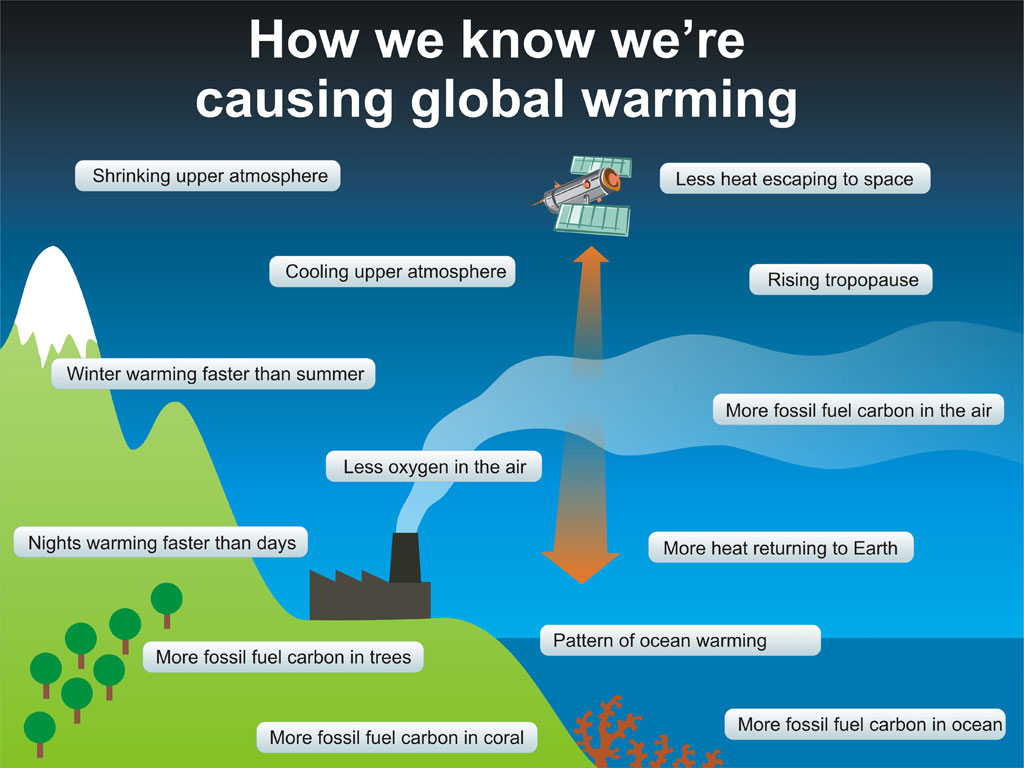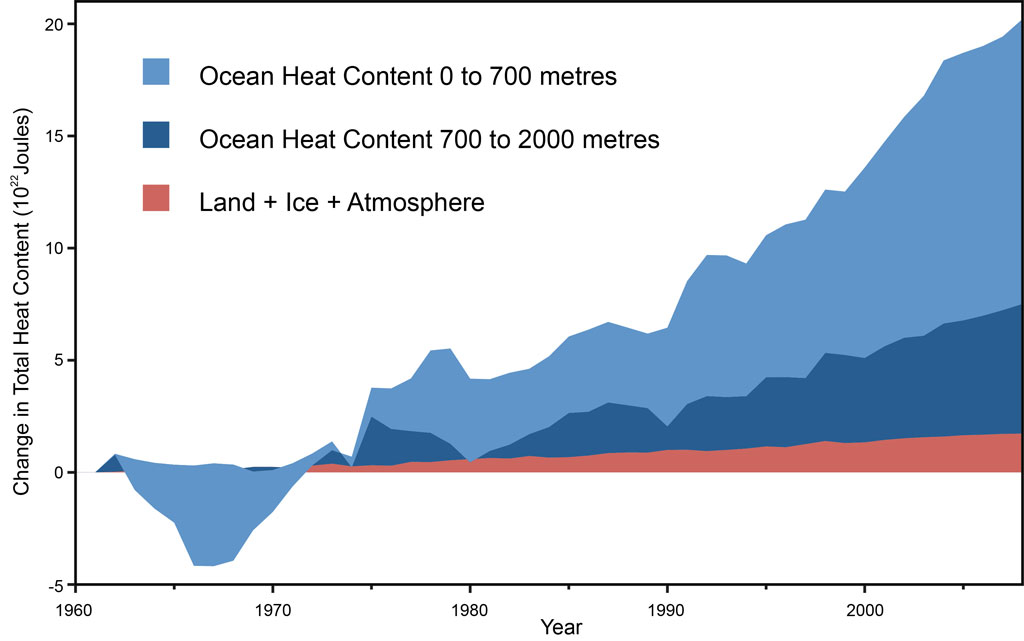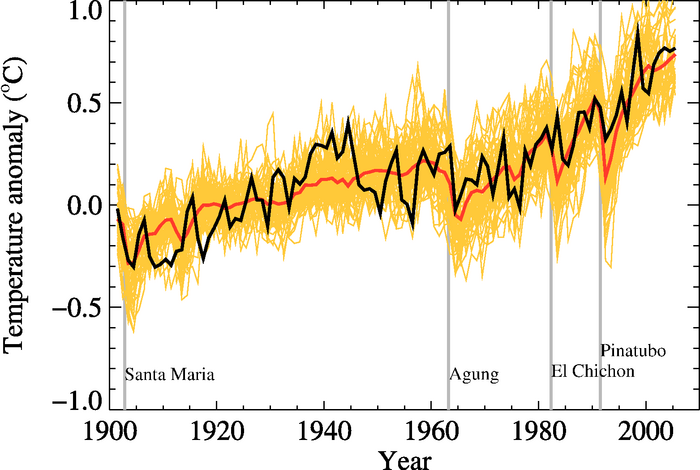Nuccitelli et al. (2013) Debunks Akasofu’s Magical Thinking
Posted on 23 September 2013 by dana1981, John Abraham, ProfMandia
One of the most important concepts to understand when trying to grasp how the Earth’s climate works, is that every climate change must have a physical cause. This principle was the basis of our new paper, Nuccitelli et al. (2013).
For example, we know the increased greenhouse effect is creating a global energy imbalance that will cause the Earth's surface temperature to rise. Any alternative explanation has to identify why the increased greenhouse effect isn't causing the warming we expect based on fundamental physics, and why the climate change 'fingerprints' are consistent with the increased greenhouse effect.
For example, it’s not sufficient to say global warming is the result of “a natural cycle” – which cycle is causing the change? For example, is it due to the Earth’s orbital cycles around the Sun, which operate very slowly over periods of thousands of years? Is it changes in solar activity, which has on average remained flat and even declined slightly over the past 60 years? Is it ocean cycles, which shift heat between the oceans and air, and don’t cause the Earth to accumulate more heat?
Recently, a brand new scientific journal called Climate published a paper by Syun-Ichi Akasofu, a retired geophysicist and former director of the International Arctic Research Center at the University of Alaska-Fairbanks. Despite having a background in physical sciences, Akasofu made a very unphysical argument in that paper. He claimed that the current global warming is merely a result of the planet “recovering” from the Little Ice Age – a cool period (the cooling mostly isolated in Europe) that lasted between the years of about 1550 and 1850.
Problem – Akasofu didn’t identify any physical cause for this supposed ‘recovery.’ Instead he engaged in what’s known as “curve fitting,” in which you take data that is correlated to your desired graph and scale it to match, then argue you’ve proven that your data is the cause of the changes shown in that graph. In other words, it confuses correlation with causation. If I can take data regarding the number of pirates in the Caribbean and consumption of spaghetti in Ireland and make it fit the global temperature data, that doesn’t mean that pirates and Irish spaghetti are causing global warming. A physical cause must be identified.
Akasofu didn’t do that. He just roughly fit some ocean cycle data to the global temperature measurements and decided that a linear global warming trend was left over. He then declared that linear trend was the “recovery” from the Little Ice Age, and that it would continue indefinitely into the future, despite not knowing its cause.
Unfortunately the peer-review process isn’t perfect. It’s necessary but insufficient in separating the good from the flawed research. Sometimes a bad paper will slip through the cracks, whether due to a poor choice of reviewers, or the judgment of the journal editor. Akasofu’s paper was published in the very first edition of Climate, which caused great concern amongst its editorial staff (many of whom recognized the poor quality of the paper), and even caused one editor to resign from the journal.
In fact, Akasofu had published a very similar paper in another journal in 2009, which I had previously debunked. John Abraham suggested that we should submit a comment to the journal based on the same points I had made in that post, and so we did, with input from our co-authors Rasmus Benestad and Scott Mandia. The main points we made in the newly published paper were as follows.
1) Lack of physical mechanisms. As noted above, Akasofu did not identify any physical causes of the supposed Little Ice Age “recovery.” Long-term temperature changes are caused by global energy imbalances, caused by factors like an increased greenhouse effect.
2) Claim of a halt to present heating. Akasofu’s paper focused on the claim that global warming has “halted,” but studies that have accounted for the warming of the entire climate (oceans, air, ice, and land) have shown that if anything, global warming is accelerating.
Global heat accumulation data (ocean heating in blue; land, atmosphere, and ice heating in red) from Nuccitelli et al. (2012)
3) Curve fitting. Akasofu merely made his desired data match the global surface temperature measurements, but global climate models match the measurements better, and they’re based on actual physics.
Global mean near-surface temperatures from observations (black) and as obtained from 58 simulations produced by 14 different climate models driven by both natural and human-caused factors that influence climate in the 2007 IPCC report (yellow). The mean of all these runs is also shown (thick red line). Vertical grey lines indicate the timing of major volcanic eruptions.
4) Failure to consider many known influences on the Earth’s climate. We know that human emissions of greenhouse gases and other pollutants, changes in solar activity volcanic eruptions, and many other factors influence global surface temperatures. Failing to account for these known factors makes it impossible for Akasofu to have correctly identified the causes of global warming in the past, present, or future.
5) Misunderstanding carbon and climate. Akasofu argued that if the underlying rate of warming since the Little Ice Age has been steadily linear (which it hasn’t), then it couldn’t have been caused by human carbon emissions, which have accelerated. First of all, the relationship between carbon emissions and temperature isn’t a linear one (there’s a natural log involved). Second, this is a straw man argument, because nobody is claiming that carbon emissions are the only factor influencing global temperatures. The figure above shows how climate models expect global surface temperatures to have changed in response to all known factors, including carbon emissions, and they reproduce the observed changes accurately.
The problem with many anything but carbon (ABC) climate contrarian hypotheses like Akasofu’s is that they throw out what we know about how the Earth’s climate works. It’s fine to try and account the influences of ocean cycles – that’s what mainstream climate scientists are doing – but we’ve known how the Earth warms in response to the increased greenhouse effect for over a century. We also know that any long-term global warming must be caused by a global energy imbalance.
Any valid climate research has to work within that known framework. When you throw out everything we know about the Earth’s climate, you’re stuck making unphysical arguments based on nothing more than correlations and curve fitting, as Akasofu did. The problem for climate contrarians is that our existing climate framework is very solid. We understand the fundamentals about how the climate operates well enough to accurately reproduce the observed changes, based on solid, well-understood physical mechanisms like the increased greenhouse effect. That’s not about to get overturned by magical thinking and curve fitting.
Note: A rebuttal to the new myth Akasofu Proved Global Warming is Just a Recovery from the Little Ice Age has been created, with the short URL sks.to/akasofu, and Basic, Intermediate, and Advanced levels.































 Arguments
Arguments

































We've seen Akasofu's unsubstantiated graph pasted onto to several climate-related commentary posts in Canadian media. As a layperson I suppose I resort to speculation at many times myself, but I can't help wondering whether his area of specialization (aurora) makes him of particular interest to other "cosmic" climate contrarians who promote the woozy ideas of Landscheidt, Mörner and Svensmark, due to some kind of neo-mysticism.
The one persistent commentator I am aware of using this swoopy-dippy climate "prophecy" seems to style himself rhetorically as some kind of high priest among contrarians. It's quite annoying really.
It would be interesting and even fun to interview Akasofu. He is quite a distinguished scientist and has no obvious ties to the extractive industries.
The previous incarnation of this Akasofu paper was actually published in 2010 (not 2009) with a prior 2009 version unpublished but appearing on line. The big difference between these two eariler attempts was length (2009 - 55 pages, 2010 - 14 pages). This latest 2013 version is shorter still. And it has nothing new to say. Not a jot.
I feel it is telling that after 4 years all that has been achieved is a bit of editing. With nothing new to prop up his bankrupt theorising, Akasofu simply demonstrates the vacuous nature of his work.
@MA Rodger
in which case this looks like academic misconduct. Journal papers are supposed to make an original contribution to the field and one normally has to sign a statement saying that the work is original and not just a rehash of previous work. The paper should have been rejected for this reason alone.
StBarnabas.
And because of it one of the members of the editorial board resigned in protest. We can but hope that the remaining members have got the message.
Republishing material is not academic misconduct. While it will usually be against the journal requirements for a research paper (but not an invited or review paper), a journal can choose to print whatever it wants. The only misconduct would be if the author had misrepresented the history of the work to the journal. We have no evidence of such a misrepresentation.
MA Rodger, according to the journal's website, TWO members of the editorial board resigned:
http://www.mdpi.com/2225-1154/1/2/74
However, compared to March 9 of this year, there are THREE names missing.
Apart from Brierley, Jason Evans and Caroline Ummenhofer no longer appear on the list of editors.
Gaia has many negative feedback mechanism to keep temperatures reverting to the mean. We have seen one of them this summer as more heat from the Arctic Ocean gave rise to low pressure systems which shaded the ocean and decreased ice melt. What is disturbing is the concept of the light switch phenomenon. The thought that when we push the system beyond some point some of the negative feed back mechanisms will no longer be enough to hold the line and we will flip into a new regime. If the slow creep we see now is disturbing, a sudden change would be far more serious. The "up the down escalator" graph suggests we may be close to another lurch upwards. Let's hope it is no more severe than the previous ones.
Does anyone have a reasonable explanaition for the summer 400mb anomalously dry tropics? ESRL 400 mb map of relative humidity departure from norm
additional info
jeff masters wunderblog stratospheric drying
I think it is perfectly ok to look at the temperature data and try to differentiate the different signals in it even without causation. Akasofu ends up with a linear and a cyclic trend and if we look at the beginning of this century and the last and a bit further it fits well. His recovery theory is a vague though and he do is tuning this back in his most recent publication. Also others have eplained the causes of the cyclic signal better and longer though chaotic at specific times (De Jager, Duhau). The finding in itself is worthwile however. On the other side of the scientific spectrum there is another approach. First there is a physical cause (CO2/warming) and then models are made to fit the data. That gives problems with the present hiatus in warming. The warming of the deeper ocean layers looks like a cover up to me. It would have been credible if it was found before the hiatus but it isn’t and if it do is real it should have been there too in 1945-1975 (HadCrut4). The agung volcano eruption in 1963 is a bit late for explaining that stop in temperature rise. If the hiatus in warming was there in that era it will probably be there now too and for another 15 years to come. It will be better to give more credits to natural variability then to hold on arrrogantly to the “we know it all and can compute it” approach.
Ger@rd: "I think it is perfectly ok to look at the temperature data and try to differentiate the different signals in it even without causation."
Sure, it's ok. It's not going to end up meaning much, but you're free to spend your time as you see fit.
Ger@rd: "That gives problems with the present hiatus in warming. The warming of the deeper ocean layers looks like a cover up to me."
Does it look that way to you? The linear trend for GMST (GISS) from 1972 to 2008 is 0.183C per decade. That's a hair under the expected trend (setting aside the diminishing transient response expected as we go back in time). What period is your alleged "hiatus" in GMST?
Do you actually believe that thousands of scientists are engaged in a "cover up"?
@DSL: Especially in the Hadcrut4 data there is a present hiatus starting at around 2004 till now arguably you could extend that to 1998. Even Dana in his debunk above needs deep sea warming to explain the present hiatus. In the temperature data there are similar (complete) events to be seen from 1945 to 1975 and 1878 to 1913 earlier then that the cycle becomes messy which is to be expected as there is more then one cycle at work. I said that it looks like a cover up. Actually I would not be surprised that there really is deep sea warming going on (but probably cyclical and part of a natural variation so not suited to debunk the hiatus). I don't believe in conspiracies but do think that in climate science too many scientists are morally and politically connected to a cause which is in itself a danger to objective observation.
Ger@rd, the trend for 1973 to 2008 in Had4 is 0.188C per decade. I'm not saying that a short-term negative/flat trend in GMST isn't occurring. What I'm saying is that you can't use the word "hiatus" unless you define it. I'm then saying that the only way to find a definable "hiatus" is to use a period that's less than a decade in length and probably more like six years. At that point, you only have to look at "the elevator" to see that such short-term deviations are normal.
The term "hiatus" needs to be further defined in light of the fact that GMST is still within the 95% confidence range for the CMIP3 regime ensemble. It's only when we compare the ensemble model mean--that less-than-meaningful line--that an appreciable deviation appears, and only within the last six years.
Ocean heat content: you say "probably cyclical." You cite no research to support that claim, nor do you account for research that supports a different view (I link the scholar search instead of specific works because I want to point out that looking at deep ocean warming is not a new thing, not scientists scrambling to come up with excuses). The word "probably" is one of the most oft-used pieces of evidence to support action. Unfortunately, that evidence only has value for the mind that uses it. I want something more.
I agree that climate science is highly politicized. That's true for any science where the stakes are high. Climate science is also perhaps the most scrutinized areas of science. It's much more difficult to get away with imprecise, off-the-cuff remarks. It's very difficult to get away with bad science--partially because of the scrutiny, and partially because climate is a highly-integrated and highly-progressive area of study. The garbage is taken out quickly, either by the usual scientific process or by nature itself.
Elevator > escalator (see graph in right-hand column)
So which seems more likely? A magical cycle with no known cause, no supporting evidence: Or something that is in accordance with known physics. If you have a TOA energy imbalance, (thats measured), what do think is happening to that energy?